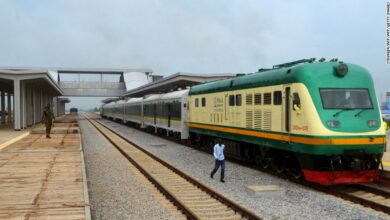On a soft September night in a medieval Cairo palace, El Tanboura, a group of musicians from Port Said, played folk songs while dancing and singing away as a fascinated audience clapped in delight.
When the El Tanboura members took the stage, each wearing a blue cap, and began to pluck strings, the spectators started clapping immediately, adding their excitement to that clearly felt by the musicians.
The tanboura, the simsimiyya, and the mizmar were played with improvisation, but it is with the addition of other instruments (the tabla, the riqq, the European triangle, and the sagat) that the music gained its momentum.
Soft and seductive, the simsimiyya (lyre) elicited a craving for more. But once the drumming and the plucking intensified, the audience jumped up and down in their seats.
Soon the rest of the group hopped on stage to perform the carefree bambouti dance, originally associated with fishermen. One foot forward, the other left, and then to the side and back, it was an assortment of joyful and energetic moves.
The performance intensified when a man in a sand-colored galabeya started spinning, and a singer in a deep crimson tarbush radiated his strong vocals to the audience.
Established in 1989, the El Tanboura ensemble is composed of men age 30-70, each of whom is determined to keep the revelry of their eclectic folk culture alive. Welcoming of such Egyptian culture is the Amir Taz Palace, built in the mid-14th century by a Mamluk prince, and today a prominent cultural center.
A combination of veteran Egyptian musicians, singers, fishermen, and philosophers, the men of El Tanboura are the self-proclaimed curators of Port Said traditional music. At the heart of the ensemble is the simsimiyya, which stirs emotion and soothes the most resilient of hearts.
The simsimiyya first appeared in Port Said in the 1930s, accompanying the Sufi-inspired chants and drumming of local suhbagiyyas (musicians).Gaining momentum, the simsimiyya became very prevalent, providing people at cafes with original folk music.
Suhbagiyya and simsimiyya were brought together by the 1956 Suez Crisis. With protest songs, simsimiyya gave voice to the resistance movement, later doing the same during the War of 1967. When Port Said was designated as a free trade zone in the 1970s, the simsimiyya suffered a brief decline as cheaper, more modern keyboard players and DJ sound systems rivaled the traditional musicians.
El Tanboura emerged to rescue folk music. In the 1980s, founder Zakaria Ibrahim spent nine years putting together a group truly reflective of Port Said. A wide audience was gradually captured by the creative music, reviving the traditions.
Last Sunday night, the El Tanboura ensemble made sure to spread glee throughout the glorious medieval palace, while simultaneously preserving their culture. World-renowned and nationally celebrated, this group simply and melodically inspires you to revel in life.




